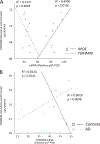DNA methylation of TOMM40-APOE-APOC2 in Alzheimer's disease
- PMID: 29371683
- PMCID: PMC6466631
- DOI: 10.1038/s10038-017-0393-8
DNA methylation of TOMM40-APOE-APOC2 in Alzheimer's disease
Abstract
The apolipoprotein E (APOE) ε4 allele is the major genetic risk factor for Alzheimer's disease (AD). Multiple regulatory elements, spanning the extended TOMM40-APOE-APOC2 region, regulate gene expression at this locus. Regulatory element DNA methylation changes occur under different environmental conditions, such as disease. Our group and others have described an APOE CpG island as hypomethylated in AD, compared to cognitively normal controls. However, little is known about methylation of the larger TOMM40-APOE-APOC2 region. The hypothesis of this investigation was that regulatory element methylation levels of the larger TOMM40-APOE-APOC2 region are associated with AD. The aim was to determine whether DNA methylation of the TOMM40-APOE-APOC2 region differs in AD compared to cognitively normal controls in post-mortem brain and peripheral blood. DNA was extracted from human brain (n = 12) and peripheral blood (n = 67). A methylation array was used for this analysis. Percent methylation within the TOMM40-APOE-APOC2 region was evaluated for differences according to tissue type, disease state, AD-related biomarkers, and gene expression. Results from this exploratory analysis suggest that regulatory element methylation levels within the larger TOMM40-APOE-APOC2 gene region correlate with AD-related biomarkers and TOMM40 or APOE gene expression in AD.
Conflict of interest statement
Compliance with ethical standards
Figures




References
-
- Cervantes S, Samaranch L, Vidal-Taboada JM, Lamet I, Bullido MJ, Frank-Garcia A, Coria F, Lleo A, Clarimon J, Lorenzo E, et al. Genetic variation in APOE cluster region and Alzheimer’s disease risk. Neurobiol Aging. 2011;32:e2107–2117. - PubMed
-
- Yu CE, Seltman H, Peskind ER, Galloway N, Zhou PX, Rosenthal E, Wijsman EM, Tsuang DW, Devlin B, Schellenberg GD. Comprehensive analysis of APOE and selected proximate markers for late-onset Alzheimer’s disease: patterns of linkage disequilibrium and disease/marker association. Genomics. 2007;89:655–65. - PMC - PubMed
-
- Bullido MJ, Artiga MJ, Recuero M, Sastre I, Garcia MA, Aldudo J, Lendon C, Han SW, Morris JC, Frank A, et al. A polymorphism in the regulatory region of APOE associated with risk for Alzheimer’s dementia. Nat Genet. 1998;18:69–71. - PubMed
MeSH terms
Substances
Grants and funding
LinkOut - more resources
Full Text Sources
Other Literature Sources
Medical
Miscellaneous
